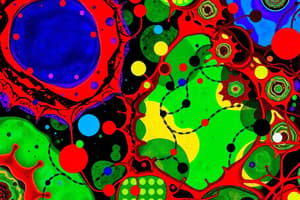Podcast
Questions and Answers
What is the significance of Robert Hooke's observations in 1665?
What is the significance of Robert Hooke's observations in 1665?
- He introduced the concept of cell theory.
- He discovered the first living organism.
- He named the small compartments he observed 'cellulae'. (correct)
- He established the idea that cells come from pre-existing cells.
Which statement best describes the cell theory?
Which statement best describes the cell theory?
- Cells do not arise from pre-existing cells.
- All living organisms consist of one or more cells. (correct)
- All cells are identical in structure and function.
- Cells are the largest unit in living things.
What advancement contributed to the development of cytology?
What advancement contributed to the development of cytology?
- The discovery of DNA.
- The invention of the telescope.
- The study of anatomical structures.
- Improvement in microscope technology. (correct)
Who were the two scientists that helped in stating the cell theory regarding the structure of plants and animals?
Who were the two scientists that helped in stating the cell theory regarding the structure of plants and animals?
What does Rudolf Virchow's statement contribute to the cell theory?
What does Rudolf Virchow's statement contribute to the cell theory?
Flashcards
Cell
Cell
The smallest unit of a living thing.
Cell Theory
Cell Theory
Cells are the basic structural and functional units of all living organisms; cells come from pre-existing cells.
Robert Hooke
Robert Hooke
An English scientist who first observed and named cells in 1665.
Cytology
Cytology
Signup and view all the flashcards
Schleiden & Schwann
Schleiden & Schwann
Signup and view all the flashcards
Study Notes
The Cell
- A cell is the smallest unit of a living thing
- Cells are the basic units of structure and function in living organisms
- A living thing, whether single-celled or multi-celled, is called an organism
- Cells are the basic building blocks of all organisms
The Cell Theory
- Cells are too small to be seen without a microscope
- In 1665, Robert Hooke used a microscope to observe cork cells, and named the compartments “cells”
- Hooke observed small compartments in dead oak cells (cork)
- After Hooke, many improvements were made to microscopes and techniques to study the details of cells
- This led to the development of cytology (the study of cells)
- Improvements allowed biologists to study the internal structure of cells in different organisms
- In 1838, Mathias Schleiden and Theodor Schwann stated that plants and animals are composed of identical cells
- In 1859, Rudolf Virchow stated that cells come from pre-existing cells
- The statements of Schleiden, Schwann, and Virchow form the basis for the development of cell theory
Studying That Suits You
Use AI to generate personalized quizzes and flashcards to suit your learning preferences.
Related Documents
Description
Explore the fundamental concepts of cells and cell theory with this quiz. Discover the historical contributions of scientists like Robert Hooke, Schleiden, Schwann, and Virchow in the study of cells. Test your understanding of the essential building blocks of life and the principles of cytology.




